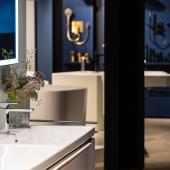The essence of decorativity
by Pamela Albanese, Tosilab (Fiorano, Italy)
For many years, decorativity was exiled from the world of styling by its mortal enemy, minimalism.
But for some time now, there’s been a resurgence of interest in embellishing our interiors with shapes, patterns and colours of more disparate temporal and geographical origin, that nonetheless have the power to conjure up new melodies in our habitat. Why? Because these decorative elements engender positive feelings and help us transcend humdrum routines with their flights of fancy.
Colour theorists have studied the idea extensively: for several seasons now, Pantone’s authoritative fashion reports have been endorsing nothing but feel-good palettes that inspire an optimistic view of life.
And the 2016 report declared rose quartz and sky blue “colours of the year” because of the sense of peace they bring.
Thanks to colour and graphics, the surfaces of a huge variety of objects become a blank page for artistic expression; and a new love of creative decoration is flourishing in every sector. Wall coverings, such as wallpaper, and home textiles are the prime movers of this revolution, and their designs and colours inject a powerful dose of emotion and evocation into interior design.
This is no surprise because the top priority of contemporary interior design is to create habitats that make people feel good.
This year, Heimtextil, one of the biggest home textile trade shows, held in Frankfurt in January, chose to call its trends section “Well-being 4.0”. This highlights the fact that for the next few years at least, the main concern of interior designers will be to make people feel good in their surroundings, wherever they are.
This trend is driven by evolving tastes and far-reaching changes to our living space, which we see more and more as a comfortable, welcoming sanctum that reflects the personality of its inhabitants. And this scope for customising living space and making it unique gives rise to a myriad of decorative ideas.
Countless subjects are ripe for decorative interpretation: exotic views, branches, foliage, flowers (the current leader), regular and irregular geometric shapes, abstract or dreamlike creations, 1950s- and 1970s-style patterns, urban graffiti, damasks and ducal motifs imbued with a shabby chic look, and refined textile or raw natural fibre effects, sometimes with precious inserts in gold or silver.
And the equally numerous techniques for image transfer include free-hand sketches, water-colours, sfumato, geometric patterns, giant prints, 3D effects and textures combined with 2D printing, and amazing nuances with alternating patterns of matt and gloss. Basically there’s so much variety that you can find a style to suit any need.
But how does today’s decorative spirit differ from previous incarnations? One of the best explanations comes from Karim Rashid, an industrial designer with a keen eye for different tones and custom effects on surfaces. In a recent interview, he pointed out that decoration becomes a meaningful part of design when it strikes an aesthetic balance with the concept behind the project as a whole, and is therefore relevant to and coherent with it.
So to make aesthetic sense, ornamentation needs to be part of a considered relationship with the other elements of the place in which it is used. In retail environments, for example, decoration is used in certain areas of the layout, and alternates with more neutral areas, so as to draw a clear distinction the respective purposes of each. But themes in these places almost always generate a new pretext for evocation, which introduces additional input that was not originally part of it.
Replay’s grunge clothing stores are a prime example, because they have recently been using black and white damask wallpaper in settings with an extremely industrial style. But instead of seeing this visual oxymoron in a strictly urban context as incoherent, we see it as a deliberate, appealing and creative contrast.
The other facet of decoration is that it enables you to draw upon visual content that you would not otherwise be able to find, as witness the increasing popularity of wallpapers featuring life-size jungle prints. This provides an effective medium for unexpected juxtapositions, which give rise to all-new combinations of styles. Two factors are at play here: the first is the contemporary nomadism, which pervades every form of culture, and fuels the trend for decorativity. It takes its cues from styles of widely varying geographical origin, reworks them, combines them and replicates their flavour in interior design.
The fluid design of the digital age complements this, because it is immaterial, kinetic and informal, to paraphrase Karim Rashid. Everything can coexist in the same place and we can flit serenely between opposing poles. This breakdown of borders between genres finds its clearest expression in wallpaper, which mixes disparate subjects to create the ideal aesthetic synthesis in terms of shapes and colours.
Regardless of whether decoration comes in the form of partitions, curtains, sound-insulating panels, wood paneling or other domestic items, and even when it uses exuberant graphics, its creative energy is never invasive, but always carefully dosed to accommodate its relationship with the other features. In doing so, it enhances the final overall effect, irrespective of whether the result is chic and understated or extrovert and eclectic.
The tendency to delimit wall decorations and avoid using them everywhere proves this point. Designers usually choose to confine them to certain areas, often unexpected ones, as Andrea Castrignano did in the apartment he designed in Via Durini in Milan, where he used graphics perfectly suited to bedrooms, but confined them exclusively to the ceiling. The aim is to draw the gaze upwards and carry the observer’s thoughts away towards an image-inspired world.
At other times, the ornamental themes are incorporated into the material and assume its colours without adding anything else, as is the case with all the microtextures literally impressed into the wood, concrete or marble of which the object itself is made.
Lastly, in the interconnected world of the visual disciplines, decoration is the ideal meeting point between art and design. Striking expressive crossovers bring famous works of art to life in everyday objects, such as accessories reinterpreting the drawings of Fornasetti, or prompt manufacturers to forge partnerships with international artists to customise their products, as the Portuguese brand Vista Alegre does.
The real power of decorativity is that it aims straight at the heart, without any need for further explanation, because it is the facet of an environment that catalyses the attention most. So as well as giving interiors a unique flavour, it’s one of the best ways of expressing emotions.
Did you find this article useful?
Join the CWW community to receive the most important news from the global ceramic industry every two weeks





















